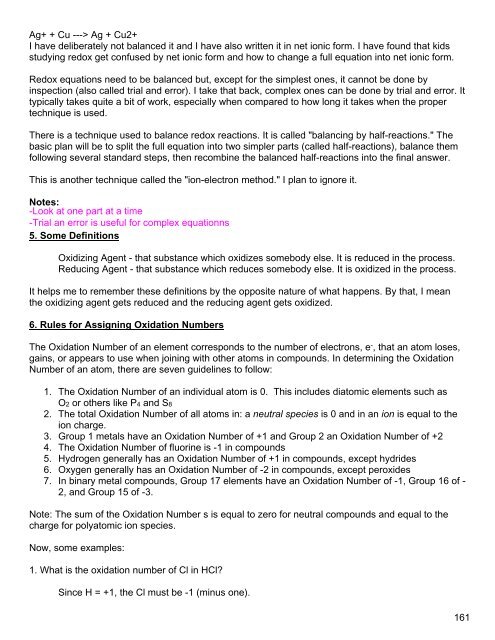Create successful ePaper yourself
Turn your PDF publications into a flip-book with our unique Google optimized e-Paper software.
Ag+ + Cu ---> Ag + Cu2+<br />
I have deliberately not balanced it and I have also written it in net ionic form. I have found that kids<br />
studying redox get confused by net ionic form and how to change a full equation into net ionic form.<br />
Redox equations need to be balanced but, except for the simplest ones, it cannot be done by<br />
inspection (also called trial and error). I take that back, complex ones can be done by trial and error. It<br />
typically takes quite a bit of work, especially when compared to how long it takes when the proper<br />
technique is used.<br />
There is a technique used to balance redox reactions. It is called "balancing by half-reactions." The<br />
basic plan will be to split the full equation into two simpler parts (called half-reactions), balance them<br />
following several standard steps, then recombine the balanced half-reactions into the final answer.<br />
This is another technique called the "ion-electron method." I plan to ignore it.<br />
Notes:<br />
-Look at one part at a time<br />
-Trial an error is useful for complex equationns<br />
5. Some Definitions<br />
Oxidizing Agent - that substance which oxidizes somebody else. It is reduced in the process.<br />
Reducing Agent - that substance which reduces somebody else. It is oxidized in the process.<br />
It helps me to remember these definitions by the opposite nature of what happens. By that, I mean<br />
the oxidizing agent gets reduced and the reducing agent gets oxidized.<br />
6. Rules for Assigning Oxidation Numbers<br />
The Oxidation Number of an element corresponds to the number of electrons, e - , that an atom loses,<br />
gains, or appears to use when joining with other atoms in compounds. In determining the Oxidation<br />
Number of an atom, there are seven guidelines to follow:<br />
1. The Oxidation Number of an individual atom is 0. This includes diatomic elements such as<br />
O2 or others like P4 and S8<br />
2. The total Oxidation Number of all atoms in: a neutral species is 0 and in an ion is equal to the<br />
ion charge.<br />
3. Group 1 metals have an Oxidation Number of +1 and Group 2 an Oxidation Number of +2<br />
4. The Oxidation Number of fluorine is -1 in compounds<br />
5. Hydrogen generally has an Oxidation Number of +1 in compounds, except hydrides<br />
6. Oxygen generally has an Oxidation Number of -2 in compounds, except peroxides<br />
7. In binary metal compounds, Group 17 elements have an Oxidation Number of -1, Group 16 of -<br />
2, and Group 15 of -3.<br />
Note: The sum of the Oxidation Number s is equal to zero for neutral compounds and equal to the<br />
charge for polyatomic ion species.<br />
Now, some examples:<br />
1. What is the oxidation number of Cl in HCl?<br />
Since H = +1, the Cl must be -1 (minus one).<br />
161



